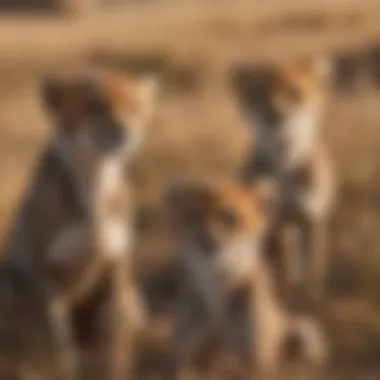Unveiling the Captivating Existence of Cheetahs in Their Natural Surroundings


Nature Topic Overview
Cheetahs, the sleek and swift rulers of the savannas, embody agility and grace in their natural habitat. From their distinctive spotted coats to their unmatched speed, these majestic felines captivate the imagination of nature enthusiasts and researchers alike. Join us on a journey into the enigmatic world of cheetahs as we unravel the mysteries of their lives amidst the vast landscapes they call home.
Fun Facts and Trivia
Did you know that cheetahs are the fastest land animals, reaching speeds of up to 60-70 miles per hour in short bursts to catch their prey? Their keen eyesight and lean bodies make them adept hunters on the African plains. Through engaging visuals and interactive elements, young readers can explore the fascinating world of cheetahs and learn about their incredible adaptations for survival.
Wildlife Explorations
In the diverse ecosystems where cheetahs reside, they share their habitat with a multitude of other species, each playing a vital role in the intricate web of nature. Explore the interconnected relationships between cheetahs, their prey, and the plants that sustain them. Engage in interactive quizzes and puzzles to test your knowledge of these magnificent creatures and their surroundings.
Environmental Awareness
Conservation and sustainability are paramount in preserving the habitats of cheetahs and other wildlife. Discover the importance of protecting these ecosystems and learn actionable tips on how children can contribute to nature conservation efforts. Empowering the younger generation to become stewards of the environment is crucial for promoting a sustainable future for all living beings.
DIY Nature Activities
Encourage hands-on learning and creativity with DIY nature activities inspired by the habits and adaptations of cheetahs. From making camouflage crafts to simulate the cheetah's spots to embarking on outdoor explorations to observe feline behaviors in the wild, there are myriad ways for children to connect with nature and deepen their understanding of these fascinating creatures.
Prologue to Cheetahs
In this section, we delve into the captivating world of cheetahs, shedding light on their enigmatic life in their natural habitat. Understanding the importance of cheetahs is paramount to appreciating their role in the ecosystem. These magnificent creatures are not only a symbol of speed and agility but also a key player in maintaining the balance of their habitats. By exploring the behavioral patterns and physical characteristics of cheetahs, we gain a deeper insight into their unique adaptation strategies to survive in the wild.
Fascinating Facts About Cheetahs
Speed and Agility
Cheetahs are renowned for their unparalleled speed and agility, making them the fastest land animals on the planet. Their acceleration and nimbleness enable them to effectively chase down prey in a matter of seconds. This exceptional trait allows cheetahs to thrive in their natural environment, outmaneuvering competitors and securing meals with precision.
Distinctive Physical Features
The sleek body and spotted fur of cheetahs serve as their distinctive physical features. These attributes not only contribute to their camouflage in various habitats but also showcase their elegance and adaptability. The unique design of a cheetah's body reflects its prowess as a supreme hunter, emphasizing the fusion of form and function in the natural world.
Hunting Techniques
Cheetahs employ a variety of hunting techniques to secure their meals, utilizing a combination of stealth, speed, and strategic positioning. Their keen eyesight and calculated approach to stalking prey demonstrate the precision with which they execute their hunting strategies. By understanding the intricacies of cheetahs' hunting techniques, we unravel the artistry behind their survival prowess.


Cheetah Habitats Overview
Savannas
Savannas serve as the quintessential domain of cheetahs, offering vast expanses with diverse ecosystems. The open grasslands of savannas provide cheetahs with ample space to spot prey from afar and unleash their lightning-fast sprints. Despite the challenges and threats presented by competing predators, cheetahs adapt to the savanna's dynamic environment, showcasing their resilience and hunting prowess.
Grasslands
Grasslands serve as hunting havens for cheetahs, where prey availability plays a crucial role in sustaining their populations. The blend of vegetation and open spaces in grasslands creates ideal hunting grounds for cheetahs to stalk and ambush their targets. By mastering the art of survival in grassland habitats, cheetahs showcase their agility and predatory instincts.
Deserts
In the harsh landscapes of deserts, cheetahs unveil their survival secrets, demonstrating extreme climate adaptations and water source management techniques. The sparse vegetation and scorching temperatures of deserts pose challenges for cheetahs, necessitating innovative approaches to endure and thrive. By unraveling the mysteries of cheetah survival in deserts, we gain a profound appreciation for their resilience and tenacity.
Behavioral Traits of Cheetahs
Social Structure
The social structure of cheetahs reveals fascinating dynamics centered around solitary tendencies and occasional group formations. Understanding the intricate social behavior of cheetahs sheds light on their communication methods and hierarchical arrangements. Despite their independent nature, cheetahs exhibit communal behaviors that underscore the complexity of their interactions within the ecosystem.
Reproduction Habits
Cheetahs' reproduction habits provide insights into their breeding cycles and parental care strategies. The intricacies of courtship rituals and mating patterns showcase the importance of genetic diversity in cheetah populations. By delving into the realm of cheetah reproduction, we uncover the intimate y of balance and continuity within their species.
Communication Methods
Communication among cheetahs encompasses a diverse range of vocalizations, body language, and scent marking. These communication methods serve as vital tools for establishing territories, signaling danger, and coordinating hunts. By deciphering the language of cheetahs, we unravel the nuances of their interactions and the significance of effective communication in their survival.
Adaptations for Survival
Camouflage Techniques
Cheetahs' camouflage techniques involve blending seamlessly into their surroundings, using their spotted coats to evade detection by predators and prey alike. The artistry of camouflage enables cheetahs to ambush targets effectively and remain undetected in various landscapes. By exploring the mechanisms behind cheetahs' camouflage, we appreciate the evolutionary marvel of their adaptive capabilities.
Physical Endurance
The physical endurance of cheetahs plays a pivotal role in their ability to sustain high-speed pursuits and withstand the rigors of their hunting expeditions. Their muscular build and cardiovascular efficiency contribute to enduring long chases and securing successful kills. By acknowledging the exceptional physical endurance of cheetahs, we recognize the sheer willpower and resilience embedded in their survival strategies.
Predator Avoidance Tactics


Cheetahs' predator avoidance tactics encompass vigilance, agility, and strategic retreats to steer clear of potential threats. Their ability to assess risk, evade danger, and outmaneuver predators exemplifies their sharp survival instincts. By dissecting the intricacies of cheetahs' predator avoidance tactics, we uncover the art of self-preservation ingrained in their genetic makeup.
Exploring Cheetahs' Home Grounds
Exploring Cheetahs' Home Grounds serves as a pivotal section in this article, shedding light on the intricate ecosystems where cheetahs reside. By delving into the savannas, grasslands, and deserts that make up their habitat, we gain a deep understanding of how these majestic creatures navigate diverse terrains. This exploration not only unveils the geographic range of cheetahs but also underscores the significance of environmental adaptation for their survival. Furthermore, analyzing the specific characteristics of each habitat provides essential insights into the challenges and opportunities these environments offer.
Savannas - The Cheetah's Domain
Rich Biodiversity
Rich biodiversity within savannas plays a vital role in supporting the intricate web of life that cheetahs depend upon. The diverse array of plant and animal species in this habitat provides ample food sources for cheetahs, highlighting the interconnectedness of ecosystems. The adaptability of cheetahs to thrive in such biodiverse environments showcases their evolutionary prowess in utilizing resources efficiently. However, rapid changes in biodiversity due to human activities pose a threat to cheetah survival, emphasizing the delicate balance that must be maintained.
Challenges and Threats
Navigating the savannas comes with its share of challenges and threats for cheetahs. Competition for prey, encroachment of human settlements, and climate change-induced disruptions are among the primary concerns. The dynamic nature of savanna landscapes requires cheetahs to constantly adapt to new circumstances, testing their resilience. Understanding these challenges not only sheds light on the complexities cheetahs face but also underscores the need for conservation efforts to mitigate potential threats and ensure their long-term survival.
Grasslands - Hunting Haven for Cheetahs
Prey Availability
The vast expanses of grasslands offer cheetahs abundant opportunities for successful hunting due to the high prey availability. Cheetahs' hunting prowess and speed are aptly showcased in these open terrains, where they can leverage their agile nature for effective pursuits. The adaptability of cheetahs to capitalize on the prey-rich environment speaks to their finely tuned predatory instincts, honed over generations of evolution. However, fluctuations in prey populations and habitat degradation pose significant challenges, underscoring the need for sustainable conservation practices.
Survival Strategies
Survival strategies employed by cheetahs in grasslands encompass a range of behaviors and adaptations aimed at maximizing their chances of thriving in this habitat. From strategic positioning during hunts to cooperative hunting techniques among siblings, cheetahs exhibit remarkable intelligence and resourcefulness. Moreover, their ability to adapt their hunting strategies based on environmental conditions highlights the flexible nature of these magnificent cats. By unraveling these survival strategies, we gain valuable insights into the complex interplay between cheetahs and their grassland habitats.
Deserts - Unraveling Cheetah Survival Secrets
Extreme Climate Adaptations
Surviving in the harsh desert environment requires cheetahs to possess specialized adaptations to cope with extreme climatic conditions. Their ability to withstand high temperatures, conserve water efficiently, and navigate vast arid landscapes speaks volumes about their evolutionary resilience. The unique physiological and behavioral mechanisms employed by cheetahs in deserts demonstrate their remarkable capacity to thrive in seemingly inhospitable settings. However, desertification and water scarcity present looming challenges, necessitating innovative conservation approaches to safeguard cheetah populations.
Water Source Management
Effective water source management is essential for cheetahs inhabiting deserts, where water scarcity prevails. Cheetahs' reliance on water sources for survival underscores the critical importance of sustainable water management practices in arid regions. Their ability to adapt their behavior to optimize water intake and utilization exemplifies their remarkable ecological acumen. Nonetheless, encroachment on natural water sources and competition with other wildlife pose significant threats to cheetahs, necessitating concerted conservation efforts to preserve these vital lifelines.
Human Impact on Cheetah Habitats


The examination of human impact on cheetah habitats is of utmost significance within the context of unveiling the enigmatic life of these majestic creatures in their natural habitat. Human activities have exerted profound effects on cheetah habitats, leading to habitat degradation, fragmentation, and loss. It is imperative to delve into the specific elements that highlight the detrimental consequences of human encroachment on cheetah territories, shedding light on the pressing need for conservation efforts to safeguard these vulnerable ecosystems.
Habitat Destruction Due to Human Activities
Deforestation:
The aspect of deforestation stands out as a major contributor to habitat destruction within the cheetah's range. Deforestation involves the indiscriminate clearance of forests for various human activities, such as agriculture, logging, and infrastructure development. This rampant practice not only diminishes the natural habitat of cheetahs but also disrupts the intricate balance of their ecosystems. The unique feature of deforestation lies in its swift and irreversible impact on biodiversity, leading to habitat loss, climate change, and dramatic declines in wildlife populations. The advantages of deforestation are predominantly economic, providing land for cultivation and resource extraction; however, its disadvantages are far-reaching, endangering wildlife and jeopardizing ecosystem stability.
Urbanization Effects:
Urbanization effects present another crucial factor contributing to habitat destruction and degradation. Rapid urban expansion encroaches upon cheetah habitats, replacing natural landscapes with concrete jungles. The key characteristic of urbanization effects is the transformation of once biodiverse regions into heavily developed areas, limiting the available space for wildlife and increasing human-wildlife conflicts. The unique feature of urbanization effects is its pervasive nature, altering ecosystems irreversibly and magnifying the challenges faced by cheetahs and other wildlife. While urbanization may offer benefits in terms of infrastructure development and economic growth, its drawbacks include habitat loss, pollution, and heightened risks to endangered species.
Conservation Efforts to Protect Cheetah Habitats
Efforts to protect cheetah habitats are paramount in mitigating the adverse impacts of human activities and ensuring the survival of these iconic felids. Conservation initiatives play a vital role in preserving remaining habitats and creating safe havens for cheetah populations to thrive.
Protected Areas Initiatives:
Protected areas initiatives represent a cornerstone of cheetah habitat conservation, establishing designated areas where wildlife, including cheetahs, receives heightened protection. These initiatives focus on safeguarding critical habitats, implementing anti-poaching measures, and minimizing human disturbances within wildlife reserves. The key characteristic of protected areas initiatives is the establishment of boundaries that delineate areas off-limits to destructive activities, ensuring the preservation of biodiversity and the conservation of species. While these initiatives offer valuable safeguards for wildlife, they may face challenges related to funding, enforcement, and human encroachment.
Community Involvement Programs:
Community involvement programs play a pivotal role in engaging local populations in conservation efforts and fostering coexistence between humans and cheetahs. By actively involving communities in conservation activities, such as habitat restoration, wildlife monitoring, and education outreach, these programs promote sustainable practices that benefit both people and wildlife. The key characteristic of community involvement programs is their emphasis on grassroots participation, empowering communities to become custodians of their natural heritage and partners in conservation endeavors. Despite their inherent advantages in promoting local stewardship and raising conservation awareness, these programs may encounter obstacles related to resource allocation, cultural attitudes, and long-term sustainability.
Future Prospects for Cheetahs and Their Habitats
Challenges in Ensuring Long-Term Habitat Preservation
Climate Change Impacts
The discussion regarding climate change impacts on cheetah habitats delves deeply into the critical role that changing environmental conditions play in shaping the future of these graceful predators. Highlighting the vulnerabilities of cheetah habitats to climatic variations, this section emphasizes the urgency of addressing climate change to ensure the long-term survival of cheetah populations. By elucidating the nuances of how climate change affects prey availability and ecosystem dynamics, readers will gain a profound understanding of the intricate relationship between environmental stability and cheetah conservation efforts.
Human-Wildlife Conflict Resolution
Within the context of human-wildlife conflict resolution, the narrative unfolds to underscore the complexities surrounding the cohabitation of humans and cheetahs. Exploring the root causes of conflict and the diverse approaches adopted to mitigate tensions, this section aims to cultivate empathy and mutual understanding between communities and cheetahs. By analyzing the benefits of peaceful coexistence and the challenges of balancing human needs with wildlife conservation, readers will grasp the significance of fostering harmonious relationships for the well-being of both cheetahs and local communities.
Innovative Strategies for Habitat Conservation
Technology Integration
The integration of technology in habitat conservation initiatives signifies a paradigm shift in the way we monitor and protect cheetah populations. By examining how advancements in tracking devices, remote sensing technologies, and data analytics enhance conservation outcomes, this section illuminates the transformative potential of technological solutions in safeguarding cheetah habitats. Exploring the advantages of real-time monitoring, predictive modeling, and anti-poaching measures, readers will gain insights into the application of cutting-edge tools to bolster conservation efforts and ensure the long-term viability of cheetah habitats.
Global Collaborative Initiatives
Global collaborative initiatives stand as beacons of hope in the landscape of cheetah conservation, epitomizing the power of international cooperation in preserving biodiversity. Delving into multinational partnerships, cross-border agreements, and collaborative research endeavors, this section underscores the collective responsibility shared by the global community towards safeguarding cheetah habitats. By showcasing the benefits of information exchange, capacity building, and joint conservation strategies, readers will appreciate the immense value of united efforts in securing a sustainable future for cheetahs and their natural habitats.







